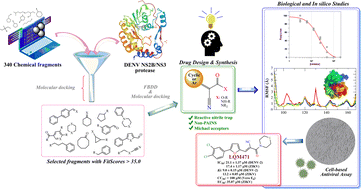Fragment-based design of α-cyanoacrylates and α-cyanoacrylamides targeting Dengue and Zika NS2B/NS3 proteases†
Abstract
Viruses belonging to the Flaviviridae family account for millions of cases of infections worldwide, mainly Dengue (DENV) and Zika (ZIKV) viruses. Both mosquito-borne flaviviruses are transmitted by bites of infected Aedes vectors, which are mainly endemic in tropical and sub-tropical countries. DENV and ZIKV are composed of structural and non-structural (NS) proteins that are initially expressed as a single precursor polyprotein. NS2B/NS3 is a serine protease complex that has a critical role during the viral replication cycle since the polyprotein processing is also accomplished by this enzyme. As an approach for developing novel NS2B/NS3 inhibitors, a virtual fragment-based drug design protocol was developed to select small fragments for new inhibitors. Based on this, we developed a series of α-cyanoacrylates and α-cyanoacrylamides targeting ZIKV and DENV NS2B/NS3 proteases. Among them, LQM467, 471, 472, and 474 were found to be active against both proteases, with Ki values ranging from 7.8 to 20 μM. Dynamics simulations revealed good stability during 200 ns for all enzyme inhibitor-complexes. Further, the MM/BPSA approach revealed that these active compounds present similar energetic profiles, corroborating our experimental data. Additionally, docking analyses showed that the compounds share similar binding poses involving the catalytic residues. Subsequently, these compounds were screened for their cytotoxic effects, showing that only LQM474 is toxic to Vero E6 cells. Thus, LQM467, LQM471, and LQM472 were evaluated on ZIKV-infected cells to determine their antiviral potential. As a result, it was verified that LQM471 is the most promising compound, exhibiting an EC50 value of 35.07 μM. Finally, in order to obtain insights into its mechanism of action, a qPCR was performed, exhibiting that LQM471 is able to reduce the viral RNA copies compared to the untreated ZIKV-infected cells, suggesting that this compound can be a promising inhibitor of virus replication. This study presents an interesting alternative to design new hit compounds against DENV-2 and ZIKV NS2B/NS3 proteases contributing to the development of new therapeutic agents against these flaviviruses.



 Please wait while we load your content...
Please wait while we load your content...